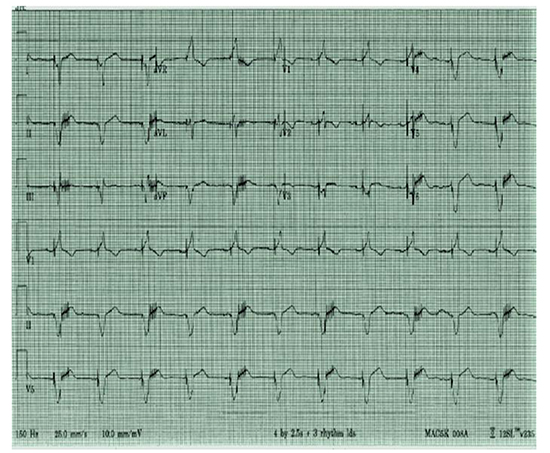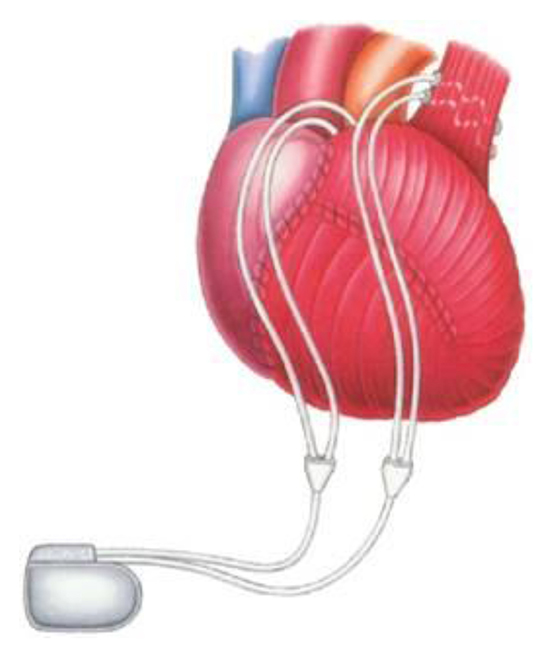A Perplexing Electrocardiogram A Perplexing Electrocardiogram
Rashmi Hottigoudar*, Dhanunjaya Lakkireddy#, Rakesh Gopinathannair#
*Tennova Heart, Knoxville, TN.#Kansas City Heart Rhythm Institute, Overland Park, KS.
Rakesh Gopinathannair, MD, MA, FAHA, FHRS Cardiac EP Lab Director, Kansas City Heart Rhythm Institute and Research Foundation Professor of Medicine, University of Missouri-Columbia 5100 W 110th St, Ste 200 Overland Park, KS 66211
A 72-year-old man was hospitalized with NYHA Class IV congestive heart failure symptoms. In 1995, the patient had undergone cardiomyoplasty procedure for nonischemic cardiomyopathy and advanced systolic heart failure.Subsequently he was implanted with a cardiac Resynchronization Therapy-Defibrillator (Consulta CRT-D,Model number D224TRK,Medtronic, Inc, Minneapolis, MN, USA). On admission, the telemetry recordingand 12 lead ECG demonstrated intermittent high frequency noise as noted in [Figure 1 and [Figure 2. CRT-D Interrogation showed normal function and normal lead parameters. What is the likely cause of this noise noted on ECG and telemetry?
Figure 1. Telemetry monitor tracing showing the noise pattern associated with cardiomyoplasty stimulator

Figure 2. 12 lead electrocardiogram showing the noise pattern associated with cardiomyoplasty stimulator

Figure 3. Dynamic cardiomyoplasty using the left latissimus dorsi muscle flap transposed into the chest and fixed around both ventricles. Reproduced with permission from Chachques JC et al1.

Patient had sinus rhythm with complete heart block as underlying rhythm.The tracings demonstrate atrial and biventricular pacing. Each P wave (paced or intrinsic) is followed by a paced QRS. The ventricular pacing artifact triggers every other beat,a burst of high-frequency pulses(6 single impulses per burst for a duration of 185 ms) delivered to latissimus dorsi muscle. The noise noted reflects the distinctive programming mode of the cardiomyostimulator device (Medtronic device Model number 4710 Cardiomyostimulator, Medtronic, Inc, Minneapolis, MN, USA).
Since its clinical application in 1985,dynamic cardiomyoplasty has been performed in more than 2000 patients. The procedure involves wrapping around the heart the skeletal muscle-latissimus dorsi, with preserved neurovascular pedicle 1. Following a gradual conditioning process, the skeletal muscle is stimulated electronically in synchrony with cardiac systole to augment myocardial contraction. The cardiomyostimulator is usually programmed in a triggered mode in which ventricular electrogram is sensed.Usually the skeletal muscle is stimulated with every other heartbeat (1:2 mode) with full burst impulses. It has also been proposed that changing the cardiosynchronization regimen to 1:4 after adequate conditioning of skeletal muscle improves hemodynamic results .Besides changing the cardiosynchronization rate to 1:8 or switching off at night would prolong the period of effective latissimus dorsi muscle performance .The beneficial effects of cardiomyoplasty on a failing heart are proposed to be due to: 1) a chronic elastic girdling effect of the stimulated muscle wrap hence stabilization of remodeling process of heart failure, and 2) Active systolic dynamic assistance leading to reduced myocardial stress and improved myocardial energetics 2.
Between July 1985 und October 1996, worldwide nearly 647 patients enrolled in Cardiomyoplasty-Skeletal Muscle Assist RandomizedTrial (C-SMART) have been reported to have received cardiomyoplasty with the Medtronic Cardiomyoplasty System3.Many of these patients are alive today. Due to the paucity of experience with this surgical procedure the ECG findings associated with this treatment modality for end stage cardiomyopathy can be perplexing to unfamiliar physicians.